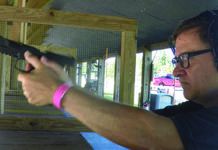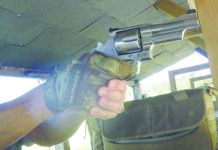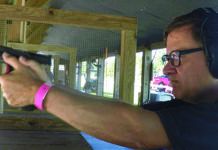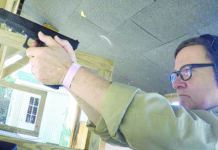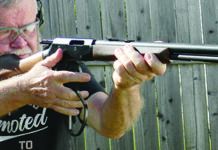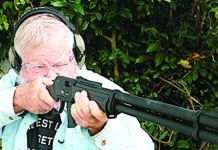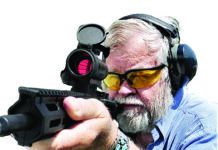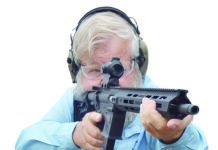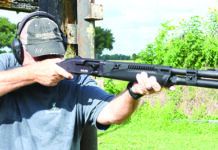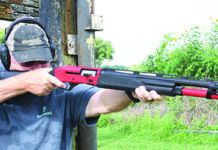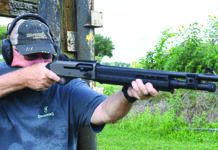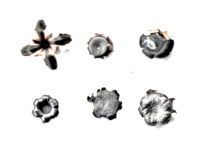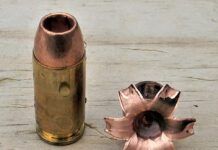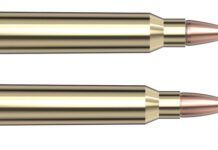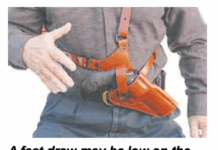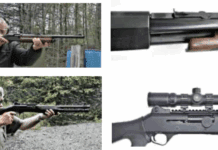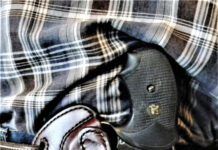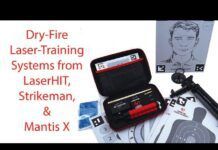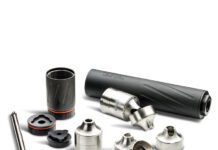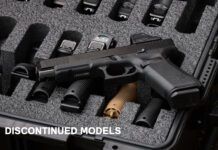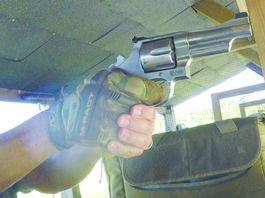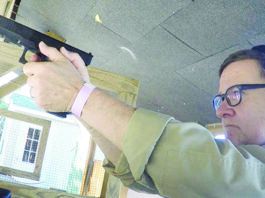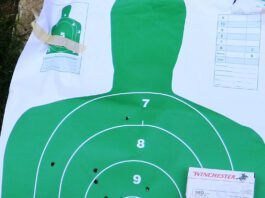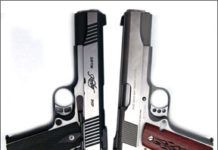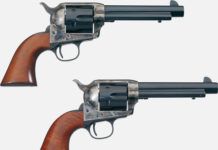Ruger or S&W Battery Mates: Which Would You Rather?
In this test we will evaluate two 6-inch heavy-barreled revolvers and two lightweight 2-inch-barreled revolvers, each paired by manufacturers. Both the $701 Ruger GP100 revolver KGP161 and the $829 686 Smith & Wesson 164224 feature stainless-steel construction, rubber grips, single- and double-action capability and weigh about 45 ounces. Both accept six rounds of 357 Magnum and/or 38 Special ammunition. Given their adjustable rear sights and generous sight radii, these guns were suitable for target competition as well as for self defense.
The little brothers were much lighter and slim enough to fit inside a pants pocket or purse. They were the $575 Ruger LCR LCR-BGXS with Hogue boot grip, and the $509 Smith & Wesson Bodyguard 38 103038, complete with built-in laser. Both of these guns were chambered for 38 Special, but similar models capable of firing the longer-cased 357 Magnum ammunition are available. Special features that make these revolvers similar were their lightweight alloy-and-polymer construction and fully enclosed "hammerless" firing mechanism, which made them snag-free and nearly impervious to being fouled by lint or other debris.
Top Hunting and Shooting Equipment Brands for 2010
International Training Inc. – Texas to Host 3 Day Advanced Pistol Course
Videos on GunReports.com!
Gun News from Around the Web: Feb 21, 2011
Federal and American Eagle Issue 45 Auto Product Safety Warning
(GunReports.com) -- Certain lots of recently manufactured 45 Auto ammunition may contain an incorrect propellant charge. Use of product from these lots may result in firearm damage and possible serious injury. DO NOT USE PRODUCT FROM THE FOLLOWING LOTS:
Gun News from Around the Web: Week of Feb 6-12, 2011
Thoughts on Concealed Carry
For more years than I'd care to recall I've had a gun secluded on my person somewhere. No, I didn't always have a CCW permit. During all those years I've never had to present the gun to stop a fight, but many times along the way I was mighty glad I was armed.
1911 Range Showdown: Colt Has Heritage, but Places Third
When it comes to 1911-type handguns, most of us think of personal defense or tactical versions of the old warhorse; however, many are used for recreational shooting and informal target shooting. Recognizing that fact, our paper-punchers wanted to burrow down into the details of target-grade 1911 pistols to see what target sights, very tight slide-to-frame fit (some Army gunsmiths weld the barrel, slide, and barrel bushing to create a new standard of tightness, an option not available to most civilian shooters), and better trigger and barrel can produce in terms of accuracy. The goal was to choose which handgun was the most accurate and best suited for informal shooting and as a base gun for upgrades to more demanding competitions.
What we learned generally is that the primary advantage of such handguns are their adjustable sights. Adjustable target-grade sights allow the shooter to adjust his sights for a wide range of bullet weights. (The 45 ACP may be useful with bullet weights of 152 to 260 grains, but the 180- to 200-grain bullets are generally the most useful for target shooting.) Also, target-grade pistols offer a fine sight picture necessary for firing good groups at longer ranges.
We tested three target-sight-equipped pistols from Colt, Kimber, and Springfield. One was the Colt Gold Cup Trophy 05070X 45 ACP, $1050 MSRP, but which we found at a counter-retail price of $963. Kimber's Eclipse Target II was the next gun, priced at $1345 MSRP and counter price of $1160. The third gun of the trio was the Springfield Loaded Model Target P19132LP, MSRP $1069 and retail price $973.
We were lucky to be able to obtain two loads especially designed for accuracy, the Federal 185-grain full-metal-jacket semi-wadcutter and the Cor-Bon 230-grain Performance Match. We also used a handload worked up just for this project, using the Oregon Trail 180-grain SWC. With these rounds we used an established method to zero a pistol with adjustable sights. If the pistol is close to the zero you want from the factory, minimal effort is required to zero the sight. If not, more work is needed. First, however, the shooter must determine click values, which will vary from sight to sight. To measure click value for each gun, we took a good benchrest position and fired a three-shot group. Next, we clicked the rear sight wedge notch five clocks to the right, then fired another group. We then measured the amount of adjustment, allowing us to precisely calculate the exact number of clicks needed to zero the piece, or the exact movement made by a single click. It doesn't matter whether you do the vertical or horizontal clicks first, but both directions need to be measured.
Also, before we get into the guts of these guns, it's worth noting at this point that some target pistols get battered to death by firing full-power ammunition—an easily avoided problem. The oft-repeated advice of fitting a full-power Government Model recoil spring to the Gold Cup is a non-sequitur. The recoil spring is full power. It is the hammer spring that is clipped and lightened to provide less resistance so that the slide will cycle with lighter loads. The Gold Cup is also supplied with a second lightweight recoil spring. Hardball or 230-grain FMJ loads usually break 830 fps. It is possible to work up a load using a 185-grain bullet at 750 fps with a proper lightweight recoil spring. Naturally, a handgun sprung in this manner would quickly batter itself into a rattling wreck with hardball loads.
SHOT Show Special Report: Uberti Offers Cattleman Two-Gun Sets
SHOT Show Intro: Rossi Wizard Pistol
Two Tokarevs: Yugoslav M57 Outshines Romanian TT-33
The Tokarev pistol replaced the old Nagant revolver in Russia in the 1930s, and what a change it was. The new semiauto zinged out an 85-grain bullet at close to 1500 fps, and was the speed king for handguns until the advent of the 357 Magnum in the 1950s, which could sometimes equal, but seldom exceed, the speed of the Mauser-designed cartridge.
The 7.62x25mm Tokarev cartridge originated before the turn of the 19th century as the 30 Borchardt, which didn't quite make the velocity of the Mauser or Tokarev cartridges, though the bullet weight was the same. It then was adopted by Mauser and was loaded hotter for his Broomhandle. The Russians copied the 1896 Mauser round essentially exactly, but put it into a much simpler handgun. While somewhat similar to the Colt 1911 design, the Tokarev was a simplification in some ways, and an advancement in others. The big thing about the Tokarev is the original design of both the TT-30 and TT-33 lacked a safety. There was a half-cock position on the hammer, but no easy way to lower the hammer once it was cocked, nor to keep it in the cocked position.
We acquired two Tokarev TT-33 variants for this test report. One was a Yugoslavian version, marked as the Model M57. It featured a well-made and cleanly installed thumb safety that permitted normal and confident cocked-and-locked carry. The other gun was from Romania and had a crude safety that had been added to permit importation into the U.S. There were other slight differences between the two that we'll get into later.
Because the takedown is identical for the two, we'll discuss that first. One of the nicer aspects of the Tokarev is a much easier takedown than that of the 1911. You don't have to wrestle the slide all the way back and hunt for a notch to get the cross pin out. And once the slide is removed toward the front, the hammer/sear group comes out as a unit for easy cleaning or replacement. The slide spring remains in the gun until you pull it out, which then permits removal of the barrel.
The Tokarev was a clean design, we thought, with an easily cocked hammer and excellent sights, though the rear one was on the high side to properly match the front blade. None of our shooters disliked the vertical grip angle of these two pistols. We all thought the grip felt natural.
The Tokarev has a barrel bushing, but turning it is not required to remove the slide. The slide spring keeps the barrel bushing in place, and once the slide spring is removed, the barrel bushing can be rotated 180 degrees to free the barrel, which comes out of the gun toward the front.
The barrels of the two guns had locking rings machined completely around their circumferences, though only the top portion locked into the slide. The benefit is much easier manufacture than that needed for a typical 1911 barrel.
Both guns exhibited a semi-gloss blued finish, and both had plastic grips that were held in place by hidden clips, accessible via the mag well. Both had lanyard rings, and both had fixed sights. The handling differences between the two were minimal, and the range results were similar. The Romanian version had a shorter grip, permitting eight rounds in the magazine instead of nine for the Yugo version. We tested them with two types of low-cost surplus ammunition, Romanian and Polish. Here's what we found.


